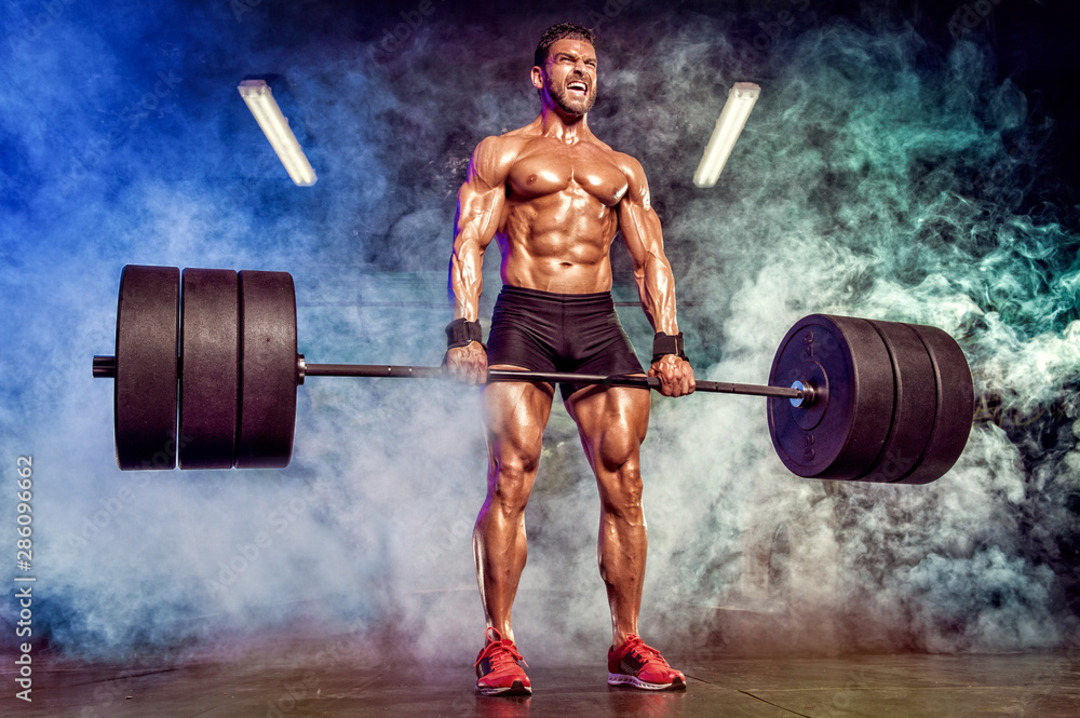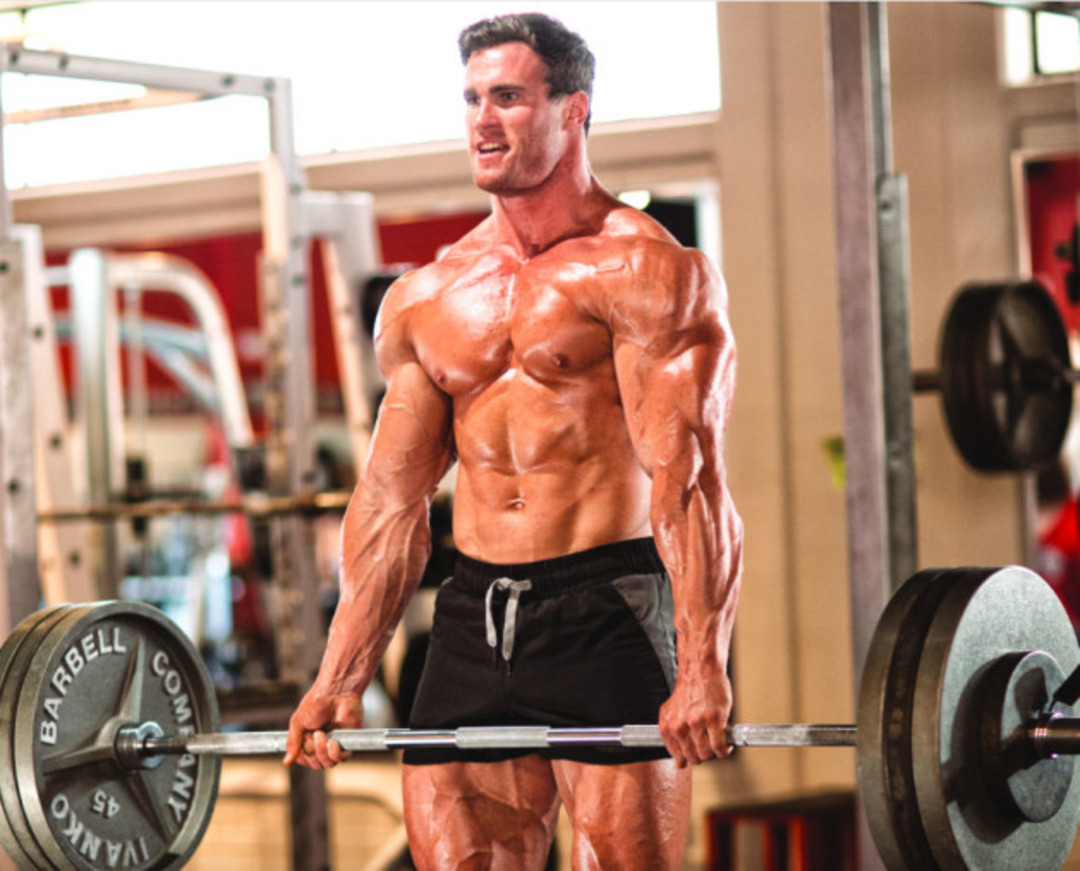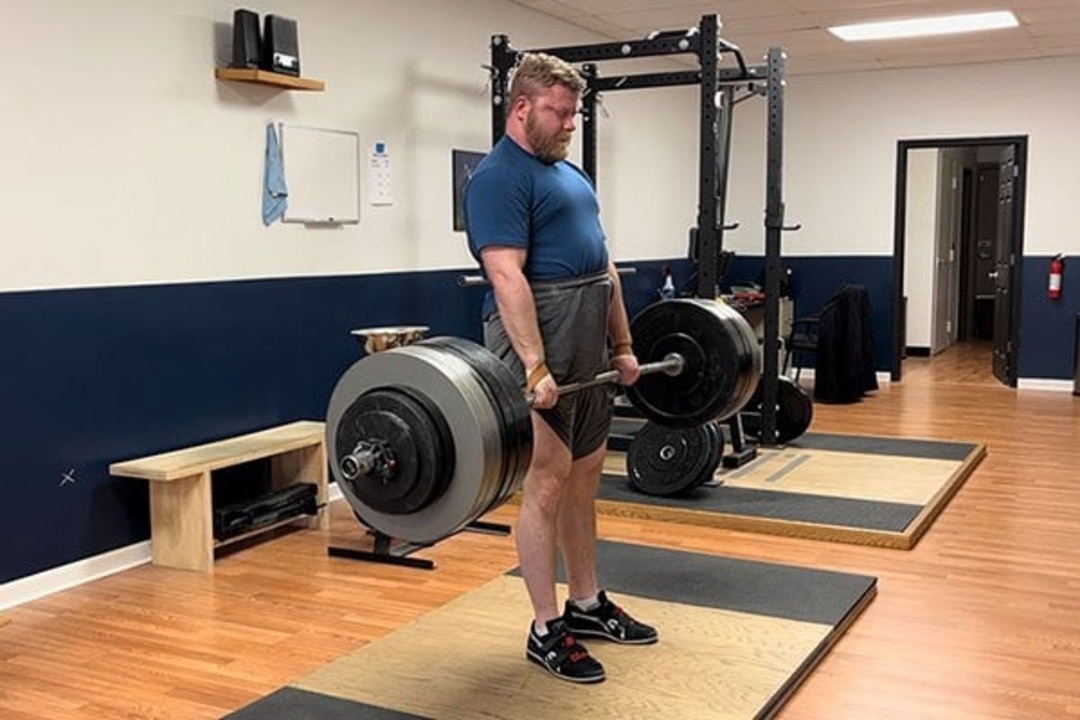What is the Average Deadlift Weight For Males?

Find out the average deadlift weight for male and see how your lifts compare to others in your age and fitness level.
You log a new deadlift number in your tracker and wonder if you are on the right path. Understanding the average deadlift weight for male lifters provides clear benchmarks across various experience levels, from beginner to advanced, showing typical one-rep maxes, bodyweight ratios, and common strength standards.
This guide breaks down realistic lifting benchmarks and training expectations, enabling you to set goals, plan your progress, and eliminate guesswork. Where should you be after six months or a year of consistent training?
GetFit AI, an AI fitness app, turns those benchmarks into simple, personalized targets and plans you can follow, using your bodyweight, experience level, and current one rep max to help you track progress and improve technique.
Summary
- Averages serve as a population-level baseline, not a personalized goal, with the Strength Level listing an average male deadlift at approximately 150 kg, an intermediate level at around 180 kg, and a novice level near 100 kg.
- Context changes meaning, for example, a 225-pound deadlift (about 102 kg) usually sits just above the novice 100 kg milestone, so it is best treated as a validated checkpoint rather than a final measure.
- Beginners progress more safely with structured blocks, such as 8- to 12-week cycles that emphasize technique, and practical micro-progressions, like adding 2.5 to 5 pounds every 1 to 2 weeks, to reduce injury risk.
- A 300-pound deadlift is above average but attainable with months or years of consistent training, while extreme lifts remain rare; for example, only 1 in 100,000 people can deadlift 405 kg.
- Meaningful progress is better tracked by workload and quality rather than single maxes, for example, monitoring weekly tonnage and work at 75 to 85 percent of your max, bar speed on near-max doubles, and testing near-max doubles every three weeks.
- Mid-level jumps, such as moving through a 315-pound barrier, usually come down to technical leaks and targeted programming, like 3 sets of 2 at 85 to 92 percent, a technique day of 4 sets of 5 at 70 percent, plus two accessory sessions per week, which often close the gaps.
- GetFit AI's AI fitness app addresses this by converting population benchmarks into personalized, progressive targets, technique cues, and recovery checkpoints based on body weight and training history.
What is the Average Deadlift Weight For Males?

Most male lifters fall into a broad band of capability, so the "average" deadlift is a baseline, not a destiny: it tells you what many lifters lift, but not what you should aim for. To make that helpful baseline, you must place it beside your bodyweight, training history, and recovery capacity.
What does "average" actually mean for different lifters?
The exact number appears differently depending on the context. Beginners see a single target and feel intimidated; experienced lifters see the same number as a checkpoint on a longer progression. When we coached novice lifters through focused 8–12 week progression blocks, the pattern became clear: uncertainty and fear of injury shrink when benchmarks convert into stepwise plans that prioritize form and small, consistent load increases.
Why do published standards matter?
Published standards give a reference, not a rule. For example, the average deadlift weight for men is 150 kg, which serves as a population-level midpoint rather than a personalized goal for Strength Level. Likewise, an intermediate male lifter can deadlift 180 kg, which provides context for what a trained, consistent program tends to produce. Use those numbers to calibrate expectations, then translate them into individualized checkpoints.
How should you personalize benchmarks to your situation?
If you weigh more, absolute numbers shift upward; if you are newer to lifting, multiples of bodyweight and movement quality should guide you. Treat benchmarks like map coordinates, not fixed destinations: they tell you where other people are, not where you must be. Progression plans that increase load by small increments, track technique, and schedule deloads help reduce injury risk and maintain steady momentum.
Most people use static standards because they are simple; however, that simplicity comes at a cost. Most lifters compare themselves to charted numbers because that method requires no new tools and feels definitive. As training complexity grows, static comparisons fragment progress tracking, push people into unsafe load jumps, and drain motivation when results stall. Platforms like GetFit AI bridge that gap by translating athlete-modeled routines into adaptive progression plans, offering technique cues, recovery checkpoints, and conversational checkpoints with athlete personas so users convert a raw average into a safe, individualized path.
What actually keeps beginners stuck, and what can be done to address this issue?
The most common failure point is treating benchmarks as binary tests instead of sliding scales. When you prioritize steady increases and recovery metrics over hitting a single number, you build strength without the panic. A simple method that works across contexts is an 8–12 week block focused on technique, gradual loading, and one planned deload, which stabilizes the stress-recovery cycle and builds confidence.
Think of averages as lenses, not labels, and then pick the lens that fits your life and history.
That apparent milestone hides a surprisingly personal answer.
Related Reading
- Best Fitness Apps
- How Many Pull Ups Should I Be Able To Do
- Average Bench Press By Age
- Average Grip Strength Male
- Average Bench Press
- How Much Does A Bench Press Bar Weigh
- Average Male Bench Press
- How Much Can The Average Man Bench Press
Is a 225 Deadlift Good?

Yes, a 225-pound deadlift is a significant achievement for many men, especially those new to training or those who are lighter in body weight. Still, it does not automatically mark you as "strong" across the board. What matters more is how that number aligns with your size, training history, and the way you achieved it.
How should you judge 225 against objective standards?
Compare by role, not by ego. According to Strength Level, A novice male lifter can deadlift 100 kg. That benchmark illustrates why a 225-pound (approximately 102 kilograms) pull often marks a significant milestone for men, which explains why many newcomers celebrate reaching it. At the same time, population averages sit higher, and those averages reflect lifters across ages, body weights, and training consistency, so one number cannot tell your whole story.
What does this feel like in practice?
This pattern appears consistently among teenagers and weekend gym-goers: 225 becomes a visible milestone, motivating them, but it also tempts rushed technique. When someone pushes for that single without organized progression, the standard failure mode is sloppy hip hinge, rounding, or over-reliance on back extension, which turns a confidence boost into a nagging injury risk. Treating 225 as a checkpoint, not a finish line, keeps you honest and durable.
Why the usual approach breaks down, and what that costs you
Most lifters manage progression by chasing raw numbers because it is simple, and social proof feels immediate. That works early, but as volume and intensity climb, this habit fragments training quality, increases recovery debt, and stalls strength gains. Solutions like athlete-modeled coaching adapt load, technique cues, and recovery checkpoints; platforms such as AI-powered training apps centralize these signals, ensuring progression remains consistent even as workouts become more challenging.
How should you progress safely from a 225 single?
If 225 came quickly, stabilize it with technique-focused sets, not max attempts. A practical block consists of three weeks of controlled doubles and triples at 75 to 85 percent of your maximum, paired with targeted posterior chain work and a planned deload in week four. Track small, measurable steps, for example, adding 2.5 to 5 pounds to the bar every one to two weeks while videoing lifts for form feedback. That approach converts the emotional win of hitting 225 into steady capacity.
What to expect emotionally as you move on
Hitting 225 often brings relief and pride, especially for younger lifters who compare themselves to peers. That surge of confidence is real and valuable, but it can also create pressure to rush heavier lifts. The smarter tradeoff is to channel that motivation into structured, measurable progress, confidence, plus a plan that beats a flashy number without staying power.
Think of 225 less like a destination and more like a validated step on a ladder; what you do next determines whether you climb or wobble.
The next question cuts deeper than a simple count: why does a 300-pound deadlift feel so rare for some lifters but attainable for others?
How Common is a 300lb Deadlift?

A 300-pound deadlift is a solid, above-average milestone for a male lifter who trains consistently; however, it is not rare in committed strength circles. Across the entire adult male population, however, it remains uncommon. In practical terms, if you train smart and prioritize posterior chain development, 300 becomes an attainable checkpoint rather than an outlandish goal.
Who tends to hit 300 pounds?
Most lifters who reach 300 share three key characteristics: a training history spanning months or years, a program that balances heavy lifts with targeted accessory work, and a body composition or bodyweight that makes the absolute load manageable. Heavier men will generally reach 300 sooner in absolute terms, while lighter men achieve similar strength by increasing the ratio of deadlifts to bodyweight. Training age, sleep, nutrition, and technique consistency matter more than raw ambition.
What training differences actually move the needle?
Problem-first: People plateau when they treat the deadlift as a single test instead of a skill to be practiced. The difference between 275 and 300 is often not a massive jump in muscle, but better leverage: improved bracing, tighter lats, faster hip extension, firmer lockout, and a grip that does not fail first. Targeted accessory lifts, such as Romanian deadlifts for hamstrings, heavy rows for back density, and heavy holds or farmer's carries for grip strength, close the small gaps that add up to a 25-pound jump.
How should you measure progress besides chasing a 1RM?
Constraint-based: testing a raw one-rep max works when you can recover and test safely; however, as training complexity increases, it becomes inefficient and risky. Track bar speed on near-max doubles, weekly tonnage at 75 to 85 percent of your max, and RPE curves across blocks; these signals tell you whether strength is building without a maximal attempt. Video feedback and simple tempo work let you isolate technical leaks, so you push meaningful weight, not bad form.
Most people handle programming by copying one-size-fits-all plans because they are easy and familiar. That approach works well initially, but it creates hidden costs as you progress: progress stalls, minor mobility issues compound, and guesswork turns consistent weeks into wasted effort. Solutions like an AI fitness app centralize progression logic, translate elite athlete routines into individualized blocks, and offer technique cues and recovery checkpoints so lifters spend less time planning and more time getting stronger.
What separates those who stall from those who break through?
Pattern recognition: the lifters who break through at mid-level weights treat recovery and marginal gains as primary levers. They prioritize sleep, adjust their nutrition around heavy days, incorporate grip-specific sessions twice a week, and rotate deadlift variations to address sticking points. Consider tuning an engine, not adding another cylinder; small, precise changes yield more usable power than haphazard increases in load.
Where 300 sits compared to accurate world-class numbers
To put this into perspective, consider that only 1 in 100,000 people can deadlift 405 kg. That All About Powerlifting finding, from 2019, shows how rare maximums at that scale are and why a 300-pound pull is far below elite, but meaningful for most lifters. Likewise, a 405 kg deadlift is considered an elite-level lift. All About Powerlifting, 2019, labels that weight as elite, which puts your 300-pound goal in a proper context: you are chasing dependable strength, not world records.
What to do next, practically
Specific experience: add a planned 6 to 10 week block that mixes volume and intensity, with one heavy day focused on triples or doubles, one technique day with lighter sets and tempo control, and two accessory sessions targeting hamstrings, glutes, and grip. Test a near-max double every three weeks rather than a full 1RM, and use that data to set the following block’s targets. If you want continuous feedback without overthinking programming, platforms such as an AI fitness app convert athlete-modeled routines into daily, adaptive instructions that keep you progressing while protecting recovery.
Ready to train like the legends and finally achieve the body you've always wanted? GetFit AI's AI fitness trainer app lets you follow the exact workout routines that helped Arnold Schwarzenegger, Kobe Bryant, Cristiano Ronaldo, Serena Williams, and over 11 other elite athletes become champions. You can also chat with them whenever you need guidance or motivation. Download the #1-rated AI fitness app for free today to get fit for less than the cost of a single month's gym membership. Because greatness isn't born, it's built one workout at a time.
That simple milestone feels settled now, but the next part will reveal a surprising truth that changes how you value more minor lifts.
Related Reading
- Bench Press Standards
- Do Pull Ups Work the Chest
- Symmetric Strength
- Average Deadlift Weight
- Grip Strength Norms
- 1 Rep Max Chart
- Average Male Deadlift
- Good Bench Press Weight
Is a 200 lb Deadlift Impressive?

Yes, a 200-pound deadlift is a credible and respectable milestone for many men, especially if you achieved it through consistent training and clean technique. What matters more than the raw number is whether that lift sits above your starting point, fits your bodyweight, and is repeatable under fatigue.
Who does this actually impress?
For lighter men and true beginners, a 200-pound pull signals rapid progress and meaningful strength adaptation, not just luck. Compared to baseline entry points, [Strength Level, 2023-10-01, a novice male lifter can deadlift 100 kg, so a 200-pound pull, which is roughly 91 kilograms, usually places you clearly beyond absolute beginner status and into early competence.
What does that number miss about real progress?
Raw weight hides nuance. Strength quality is evident in consistency, bar speed, and how the lift holds up after three exhausting sets, rather than in a single flashy rep. In population terms, higher tiers exceed 200 pounds; for example, according to Strength Level, an intermediate male lifter can deadlift 180 kg, which underscores that 200 pounds is an early milestone on a long continuum, not a final achievement.
Why comparisons make people feel small, and what to do about it
This pattern appears consistently in gyms: someone hits 200, posts a video, and then measures themselves against elite lifts, feeling deflated. That discouragement usually stems from comparing absolute numbers, instead of tracking relative gains and skill. Focus on measurable signals you control, such as adding small, regular load increases, maintaining technique under low rest, and closing weak links, like grip and hip drive. Treat the 200 as a reliable checkpoint, not an identity.
Most people manage progress with random programs because they are familiar and straightforward. That works early, but as training demands grow, inconsistent cues and one-size plans fragment progress and waste effort. Platforms like GetFit AI replicate athlete-modeled routines and translate them to your body weight and training history, providing adaptive sets, technique cues, and recovery checkpoints that keep progression coherent rather than scattershot.
What practical checks prove the 200-pound lift is meaningful?
Use outcomes that demonstrate transfer: can you perform multiple quality sets at a planned working weight? Does posterior chain volume increase over time? And does your form remain braced as reps accumulate? A simple test is repeatability, for example, logging five solid sets at a submax working load across four weeks while reducing grind on the last rep. Those wins matter more than a single heavy number.
Think of the 200-pound lift like a verified step on a ladder, not the top stair; it tells you you are climbing, but not how high you will go next.
That next question reveals a surprising shift in how we value bigger numbers.
Is a 315 lb Deadlift Impressive?

Yes, a 315-pound deadlift reads as impressive for a lot of lifters, but the question you should ask is which lifters and under what rules. In absolute terms, it signals meaningful posterior chain capacity; in relative terms, its value depends on your body weight, how you trained for it, and whether that lift is raw or assisted.
Who considers 315 a significant milestone?
Pattern recognition: athletes who train consistently for months rather than weeks treat 315 as a checkpoint. For a 170 to 200-pound male, it often represents a strong lever of power relative to body mass, while for heavier athletes, it can be an expected stage. A proper comparative anchor from StrengthLog states an intermediate male lifter can deadlift 285 lb, which frames 315 as edging beyond the intermediate band and into clearly above-average territory for trained gym-goers.
What technical gaps usually appear right around 315?
Specific experience: the most common failure modes are slow hip extension, early back rounding under load, and grip fatigue. The corrective work that moves numbers here is precise, not dramatic: three-week blocks that prioritize heavy doubles at near-max intent, paused deficit pulls for first-movement speed, and targeted hamstring and upper-back density work. For example, program a heavy day of 3 sets of 2 at 85 to 92 percent of your estimated max, a technique day of 4 sets of 5 at 70 percent with tempo control, and two weekly accessory sessions focused on glute-ham raises and heavy rows.
Most people use the same off-the-shelf plan and accept slow returns.
Most lifters follow cookie-cutter linear programs because they are straightforward and familiar. That approach works until small technical leaks and recovery mismatches compound, turning consistent weeks into slow plateaus. Solutions like GetFit AI map athlete-specific routines into adaptive progression, offering set prescriptions, auto-regulated intensity adjustments, and technique cues, so the program tightens around your actual rate of recovery and sticking points rather than forcing you to chase a one-size-fits-all number.
How should you judge progress beyond a single 315 pull?
Problem-first: A one-rep max is a noisy and emotionally charged experience. Track repeatability and workload instead, for example, weekly tonnage across heavy blocks, bar speed on near-max doubles, and the number of submax sets you complete at a given RPE. Think of it like tuning an engine by RPM stability, not by a single top-speed run; consistent increases in sustainable workload predict future 1RM gains far better than occasional maximum attempts.
When does 315 stop being impressive?
Constraint-based: 315 loses luster when context removes its difficulty, for instance, when a lifter uses lifting straps, briefs, or a suit in training, or when bodyweight and leverage make that load routine. At the top end of the sport, the same source frames a different expectation, noting that a male advanced lifter can deadlift 410 lb, which shows how standards scale with expertise and specialization. If your goal is athletic transfer or durability, raw, strapless, and repeatable strength matters more than the single heaviest number.
A short comparison you can act on: prioritize repeatable triples and doubles, fix the top-three technical leaks you list after a filmed session, and treat wise accessory choices as investments that compound into larger, safer lifts.
That next detail changes how admirable a lift really feels, and it is also where the athlete persona you follow can make a surprising difference.
Make Your Favorite Athlete Your Fitness Trainer | Try GetFit AI's AI Trainer App for Free Today
We know turning averages into a usable, day-to-day plan is where most people stall, so consider GetFit AI. This tool converts benchmarks into progressive workouts, technique cues, and recovery checkpoints tailored to your body and training history. The results are evident in real-world use, as seen with GetFit AI. 90% of users reported improved fitness levels within 3 months. With strong user sentiment, it boasts a rating of 4.8 out of 5 stars on the App Store.
Related Reading
- Average Deadlift Weight Kg
- Best Hiit Workout App
- Average Bench Press By Age 16
- Best Free Workout Apps
- Average Deadlift Weight For Male
- Best Workout Apps
- Average Bench Press Kg By Age
- Best Calisthenics Workout App
- Best Workout Tracker App
- Best Gym Workout App



.png)











